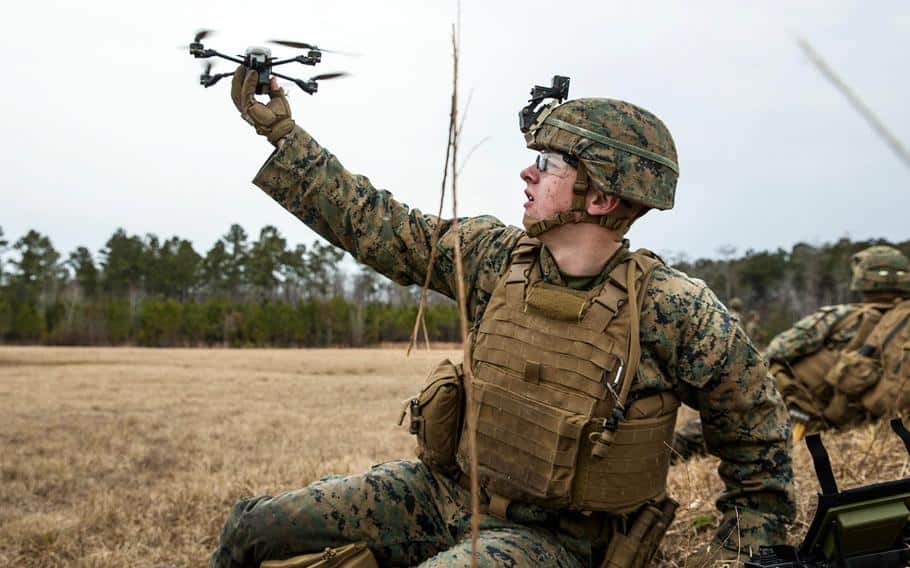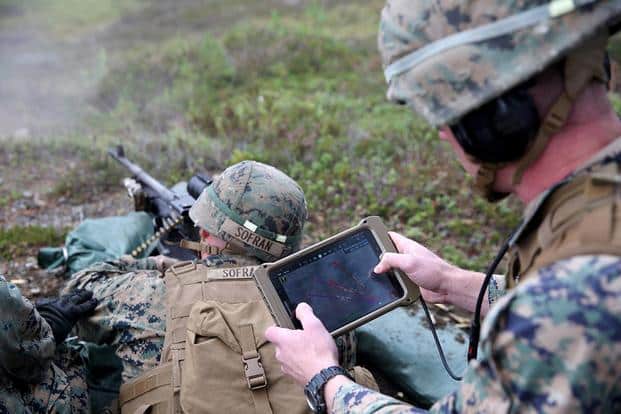Travis Pike

The Marine Corps does a lot of things well. One of those things is to do more with less, and as you’d expect as a result, another is to innovate. However, the plans for the new Marine Corps rifle squad seem to suggest the Corps might be moving away from that ‘more with less’ reputation. The modern Marine squad will be doing a lot more with… a lot more. The Marine Corps has been on a roll as of late, becoming a leaner, more capable fighting force for new kinds of conflict and adjusting its makeup to suit. A big part of that comes down to the individual squad, and that squad is changing drastically.
The squad might well be changing, but the mission of the Marine rifle squad will not. They will continue to locate, close with and destroy the enemy by means of fire, maneuver, and close combat. Here’s what that’ll look like moving forward.
The Future Marine Rifle Squad Structure
The traditional Marine Corps squad consisted of a squad leader and three fireteams of four Marines. Fireteams consisted of a team leader, an automatic rifleman, an assistant automatic rifleman, and a rifleman.
The latest squad eliminates the rifleman and assistant automatic rifleman positions. All Marines carrying M27s have automatic capability. Additionally, each fireteam will have a grenadier also carrying the M27 IAR.

The squad size is changing from 13 to 15 Marines. The squad leader will be joined by an assistant squad leader and a systems operator. These two new positions, alongside a Corpsman, give the Marine squad 16 guns total.
Let’s do some math for Marines. More guns is better than fewer guns. And two extra Marines gives the squad more guns.
The replacement of a belt-fed light machine gun was controversial. However, it seems like 16 automatic rifles would be one helluva way to replace the missing firepower an M249 offered. This new Marine rifle squad does not take into account weapons platoon attachments, namely machine gunners armed with belt-fed weapons with crew members carrying additional M27 IAR rifles.
The New Roles Within the Marine Rifle Squad
The new positions within the Marine Corps rifle squad open up the squad’s capabilities and control. The Marine Corps is big on leadership at the lowest levels. In my time working with both the Navy and Army, I never saw that culture repeated — but in the Corps, you’re a leader the minute you get a stripe on your collar. This leads the culture to produce squads with more autonomy and leadership capabilities than you’re apt to find elsewhere.
 Courtesy of Battle Order
Courtesy of Battle OrderTack on new capabilities, and you are improving the leader’s ability to carry out their commander’s intent. To make this all possible, the Marine Corps added two of the following roles, and rebooted a third.
The Assistant Squad Leader
The old Marine Rifle Squad often used an assistant squad leader in the form of the first fire team leader, who is traditionally the most experienced and trusted among the fire team heads. A dedicated assistant squad leader ensures the fire teams all have adequate leadership without tacking a second job onto any of their responsibilities.
At the same time, the assistant squad leader can accomplish mission-critical tasks that could take away from the squad leader’s ability to control his squad in combat. Specifically, the assistant squad leader can now manage comms with command and manage and coordinate fires, leaving the squad leader to focus on the fight. Coordinating fires means communicating to relay target information and friendly positions for artillery, mortar, and air strikes, among others. These tasks are essential in a fight, but can take away from a squad leader’s situational awareness, and as a result, their ability to lead their squad.
 (U.S. Marine Corps photo by Lance Cpl. Devan K. Gowans)
(U.S. Marine Corps photo by Lance Cpl. Devan K. Gowans)I remember that in the midst of a rather intense firefight, our command was constantly wanting an update from our squad leader. They called over and over as he worked to manage covering fire and maneuver elements against an emplaced enemy. I can’t remember his exact words to higher, but it was something like, “I’m shooting people right now. I’ll call you back later.”
The assistant squad leader can now manage these tasks and others on the squad leader’s behalf. If I was a squad leader, my assistant would be helping to complete a variety of combat and logistical tasks like medical evacs, tactical sight exploitation, and POW handling. At the same time, the assistant squad leader will be receiving valuable training for a future role as a squad leader themselves.
The Marine Systems Operator
As we step into modern warfare, we are seeing the implementation of modern electronic systems that can greatly benefit the guys on the ground. The newly created position of Marine Systems Operator replaces the position of radio Marine. While the System operator will be tasked with carrying the squad’s radio, they will expand into other systems as well.

This includes the use of quadcopter-based reconnaissance devices. These small ‘drones’ allow a Marine squad to enhance their situational awareness with discretion. It promises to be the new eyes of the squad leader and enhance their capabilities in urban warfare by providing an overhead view of the battlespace that wasn’t previously available at the squad level. This stealthy tool can spot threats ahead of time and provide general recon without risking members of the Marine rifle squad.
Other gear and likely duties for these roles
Additionally, the implementation of a squad range finder might be delegated to the system’s operator, but it’s a tool that could be used by the assistant squad leader as well. On top of the range finder, the Marine Corps aims to improve communications through the use of tablets. The Marine Corps Common Handheld tablet will allow commanders to transmit real-time information to the squad through commercially available devices.

This allows command or fellow squads to transmit important real-time information, including maps, locations, pictures of potential high-value targets, and much more. I speculate that the tablet likely connects to the quadcopter’s camera. The systems operator will likely also be tasked with utilizing other cutting edge systems like the HIIDE biometrics tool, TSE gathering cameras, and more.
The Grenadier
Grenadier was a role traditionally reserved for fireteam leaders. Of course, just like coordinating fires can distract the squad leader from his or her primary responsibilities, this often forced fireteam leaders to be either good grenadiers or good team leaders. When a leader’s focus is on putting 40mm HEDP on bad guys, they might not be focusing on their leadership tasks. Moving this to another position allows the team leader to focus on leading.

The use of a new grenade launcher also makes the role more malleable and versatile, but that and the Marine rifle squad’s weaponry will be the subject of part 2 of our article on the future Marine rifle squad. So watch this space for part 2 of this article.
No comments:
Post a Comment